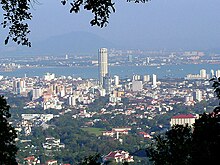Greater Penang Conurbation


The Greater Penang Conurbation that covers all of Penang and southern Kedah is the second largest metropolitan area in Malaysia. It is centred in George Town, Penang's capital city and also the second most populous city in Malaysia after Kuala Lumpur.[1][2][3] As such, this conurbation is alternatively referred to as the George Town Conurbation.
Greater Penang is home to between 2.5 million and 3 million inhabitants, the second most populous conurbation in Malaysia after Greater Kuala Lumpur (Klang Valley). In addition, Greater Penang serves as the major metropolitan area within northern Malaysia and one of the nation's manufacturing powerhouses; Bayan Lepas, in particular, is known as the 'Silicon Valley of the East' due to the concentration of electronic and engineering firms. George Town, a UNESCO World Heritage Site, is a major tourist destination within Southeast Asia, as well as the financial hub of northern Malaysia with the presence of several international banks in the city.
Penang also has the highest population density of all Malaysian states at 1,490/km2 and is one of the most urbanised states, with a recorded urbanisation level of 90.8% as of 2015.[4]
The Greater Penang Conurbation has well-developed logistical links and infrastructure. It is well-connected via the Penang International Airport, one of the busiest airports in Malaysia, and the Port of Penang. Penang Island is linked with the rest of Peninsular Malaysia via the Penang Bridge and the Second Penang Bridge.
Definition

Greater Penang encompasses the entire state of Penang - which comprises Penang Island and Seberang Perai - and the southernmost portion of the neighbouring state of Kedah. According to certain definitions, the conurbation also covers parts of northern Perak that borders Penang, specifically the agricultural town of Parit Buntar.[3][5][6]



George Town, the capital city of Penang, is the most thriving and urbanised part of the Greater Penang Conurbation. The other major urban centres on Penang Island are Bayan Lepas and Balik Pulau, the latter of which is located at the western coast of Penang Island.
Over on the mainland, Butterworth serves as the heart of Seberang Perai, while the other major towns in Seberang Perai include Bukit Mertajam, Perai, Nibong Tebal and Kepala Batas. The towns in southern Kedah that are covered under Greater Penang are Sungai Petani, Kulim and Bandar Baharu.
The local councils within the Greater Penang Conurbation are as follows.
Penang :
Kedah :
- Sungai Petani Municipal Council
- Kulim Municipal Council
- Bandar Baharu District Council
Population by Local Government Jurisdictions
The population table is based on the 2010 official census for the local government areas within the George Town Conurbation.[7]
| Local government area | Local government body | Population |
|---|---|---|
| Penang Island | Penang Island City Council | 708,127 |
| Seberang Perai | Seberang Perai Municipal Council | 818,197 |
| Sungai Petani | Sungai Petani Municipal Council | 443,458 |
| Kulim | Kulim Municipal Council | 281,260 |
| Bandar Baharu | Bandar Baharu District Council | 41,352 |
| George Town Conurbation | - | 2,292,394 |

Transportation


Public transportation is relatively more extensively developed within Penang, as the Rapid Penang public bus service, which runs over 40 routes throughout the state, was launched in 2007. Rapid Penang has also commenced cross-state bus services linking Butterworth with Sungai Petani and Parit Buntar.[8]
The Penang International Airport serves as the major airport within Greater Penang, and by extension, northern Malaysia. It is the second busiest airport in Malaysia in terms of cargo tonnage and the third busiest in the country in terms of passenger traffic. The airport is also relatively well-connected with several major regional cities such as Kuala Lumpur, Singapore, Bangkok, Jakarta, Ho Chi Minh City, Taipei, Hong Kong and Guangzhou.
The Port of Penang is one of the major sea ports in Malaysia, serving primarily the northern region of the country. The Port, with three terminals in Butterworth and one in George Town, handled over 1.1 million TEU of cargo in 2010, the second largest amount in Malaysia.[9] The well-developed air and sea transportation infrastructures in Penang has facilitated the growth of the manufacturing sector within Greater Penang by enabling the flow of goods into and out of the factories in Bayan Lepas, Seberang Perai and Kulim.
The North-South Expressway, the main arterial highway that runs through western Peninsular Malaysia and on to Singapore, also passes through the Greater Penang Conurbation via the Sungai Petani - Butterworth - Perai - Juru - Bandar Baharu route. The expressway also branches out towards the Penang Bridge and the Second Penang Bridge, thereby providing road connections between Penang Island and the rest of Peninsular Malaysia.
In addition to the two bridges, the Penang Ferry Service also connects George Town and Butterworth, with four ferries plying the Penang Strait daily.
References
- ^ "Government banks on intensive urbanisation to pull investment". The Malaysian Insider. 16 August 2010. Retrieved 19 June 2013.
- ^ "Turning Penang into a model state". The Edge. 4 October 2010. Retrieved 19 June 2013.
- ^ a b "The State of Penang, Malaysia : Self-Evaluation Report" (PDF). OECD Reviews of Higher Education in Regional and City Development. National Higher Education Research Institute (2010).
- ^ "Massive projects in place to alleviate urbanisation in Penang". 2016-10-29. Retrieved 2016-11-26.
- ^ Hamdan Abdul Majeed (27 April 2011). "The George Town Conurbation Plan". Khazanah Nasional. Retrieved 19 June 2013.
- ^ "Penang : Malaysia's stepchild or prodigal child?". Penang Monthly. 2015-07-11. Retrieved 2016-11-26.
- ^ "Key summary statistics for Local Authority areas, Malaysia, 2010" (PDF). Department of Statistics, Malaysia. Retrieved 19 June 2013.
- ^ "Rapid Penang | www.rapidpg.com.my". www.rapidpg.com.my. Retrieved 2016-11-26.
- ^ "Measuring the Performance of Malaysian Container Ports" (PDF). Maritime Institute of Malaysia.
